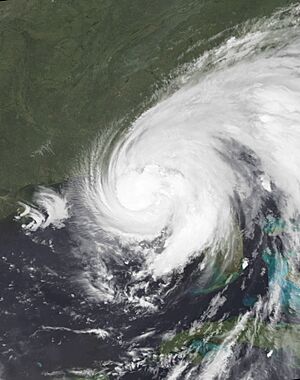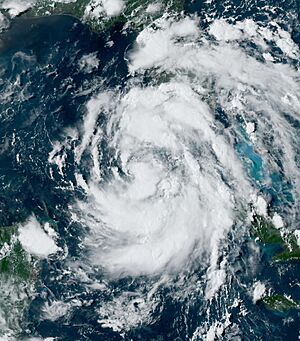Hurricane Debby (2024) facts for kids

Debby near landfall in Florida at peak intensity early on August 5
|
|
| Meteorological history | |
|---|---|
| Formed | August 3, 2024 |
| Post-tropical | August 9, 2024 |
| Dissipated | August 14, 2024 |
| Category 1 tropical cyclone | |
| 1-minute sustained (SSHWS/NWS) | |
| Highest winds | 80 mph (130 km/h) |
| Lowest pressure | 979 mbar (hPa); 28.91 inHg |
| Overall effects | |
| Fatalities | 10 total |
| Damage | ≤$2 billion (2024 USD) |
| Areas affected |
|
|
Part of the 2024 Atlantic hurricane season |
|
Hurricane Debby was a strong storm that moved slowly and caused a lot of flooding in the Southeastern United States in August 2024. It was the fourth named storm and the second hurricane of the 2024 Atlantic hurricane season. Debby started as a tropical wave. It grew stronger as it moved across Cuba and the Florida Straits. It became a Category 1 hurricane before hitting Steinhatchee, Florida.
Debby then weakened but kept moving slowly over the southeastern U.S. This brought heavy rain and widespread floods. It went back into the Atlantic Ocean, then hit South Carolina before finally weakening. States like Florida, Georgia, and North and South Carolina declared emergencies. Heavy rains fell, with some areas getting over 20 inches (51 cm) of rain. The storm also caused two dozen tornadoes. Sadly, ten people lost their lives due to the storm. Early estimates suggest the damage could be up to $2 billion.
Contents
How Hurricane Debby Formed
The National Hurricane Center (NHC) started watching a tropical wave on July 26. This wave was moving across the Atlantic Ocean. It passed over the Virgin Islands, Puerto Rico, and Hispaniola. By August 1, it became more organized. As the system moved over southeastern Cuba, it began to form a center.
Because the storm might threaten Florida, the NHC called it Potential Tropical Cyclone Four on August 2. After leaving Cuba's southern coast, it became a Tropical Depression Four on August 3. It then moved into the Gulf of Mexico. There, it grew stronger and became Tropical Storm Debby later that day.
Debby was a large storm, but its center was small. This made it harder for it to get stronger quickly. However, it kept organizing as it moved across the Gulf. By August 4, Debby became a hurricane.
Debby's Journey and Weakening
Debby turned slightly northeast. It reached its strongest point with winds of 80 mph (130 km/h) and a pressure of 979 millibars (28.9 inHg). On August 5, it made landfall near Steinhatchee, Florida. After moving inland, Debby weakened into a tropical storm.
The storm then slowed down a lot. It moved off the coast of Georgia on August 6 as a weak tropical storm. But it got a bit stronger again, reaching 60 mph (97 km/h). By August 7, Debby slowly moved north again. It made landfall a second time near Bulls Bay, South Carolina, on August 8.
Once inland, Debby steadily weakened. It became a tropical depression later that day. The NHC then handed over warnings to the Weather Prediction Center. Early on August 9, Debby became a post-tropical cyclone. The storm's leftover parts moved into Canada on August 10.
Getting Ready for the Storm

More than 1,000 flights were canceled because of Hurricane Debby. This included many flights from American Airlines.
United States Preparations
Florida
On July 31, the NWS Miami warned about possible heavy rain. Areas like the southern Florida Keys were put under a tropical storm warning. Other warnings were issued for different parts of Florida's coasts. A hurricane warning was also declared for areas between the Suwannee River and Indian Pass. The Storm Prediction Center warned about a chance of tornadoes.
Governor Ron DeSantis declared a state of emergency for 61 counties in Florida. He also called up 3,000 members of the Florida National Guard. President Joe Biden approved a disaster declaration for Florida on August 4. The mayor of Gainesville also declared a local emergency.
Many places opened up for people to get sandbags. Over 30,000 sandbags were given out in Tampa. Shelters were opened in several counties, including Leon and Lake. Some coastal areas, like Franklin and Citrus County, issued mandatory evacuations. This meant people had to leave their homes. All state parks in Florida closed. Carnival Cruise Line also changed its ship schedules.
Georgia and the Carolinas
Coastal Georgia was placed under storm surge and tropical storm warnings. Governor Brian Kemp declared a state of emergency for Georgia on August 3. Sandbagging sites also opened across coastal Georgia. Some school districts, like Long County School District, delayed their start dates. Savannah-Chatham County Public Schools closed schools for a few days.
On August 4, Governor Henry McMaster declared a state of emergency in South Carolina. The state's Attorney General also stopped unfair price increases during the disaster. Marine warnings were issued for waters near Beaufort and Hilton Head Island. Congaree National Park closed, expecting a lot of rain. All parks in Columbia also closed. About 50 first responders from Maryland and Washington, D.C., went to Charleston to help with search and rescue. Charleston also had a curfew.
In North Carolina, flood watches were issued for the southeast. Governor Roy Cooper declared a state of emergency for the entire state.
Other U.S. Areas
Parts of Pittsburgh were put under a flood watch on August 9. The National Weather Service issued a wind advisory for New York City. Winds of 50 mph (80 km/h) were expected. The Metropolitan Transportation Authority (MTA) installed pumps to remove water from subway systems. This was to prevent flooding like in past storms. Races at Saratoga Race Course were canceled. The New York Yankees also postponed their game due to the weather. Hershey Park closed on August 9.
Debby's Impact
Caribbean
Before Debby became a hurricane, it caused thunderstorms over Hispaniola, Puerto Rico, and The Bahamas. The National Weather Service issued flood warnings for many towns in Puerto Rico. Debby also brought heavy rain to western Cuba. Roads in Havana became slippery. The heaviest rain in Cuba was in Artemisa Province, with 265 millimetres (10.4 in)* falling in one spot.
United States Impact
Amtrak changed or canceled many train schedules from August 6-9. Heavy rain, strong winds, and fallen trees delayed many trains in the Mid-Atlantic and Northeastern United States on August 9.
Florida

Debby's outer bands started affecting Central and South Florida on August 3. They brought strong winds and rain. Several tornado warnings were issued. A short EF1 tornado happened in Union County. It flipped a trailer and damaged a shed and trees.
Storm surge of over 2 feet (0.61 m)* flooded Fort Myers Beach. This area was still recovering from Hurricane Ian's record storm surge. Beach erosion caused road closures in Siesta Key. The city of Sarasota recorded over 20 in (510 mm) of rain. As Debby hit Florida, almost 250,000 homes lost power. Duke Energy sent 350 workers to help restore power. In Cocoa, Debby flipped five trailers. Two people died in a car accident in Dixie County because of the bad weather.
Georgia and the Carolinas
In Georgia, about 47,000 customers lost electricity. A 19-year-old died in Moultrie when a tree fell on his home. Due to flooding along the Ogeechee River, officials in Effingham County ordered people to evacuate roads near the river.

Seven tornadoes were confirmed in South Carolina. Two of these were EF1 tornadoes that hit Edisto Beach. They damaged several homes and broke many trees. In Colleton County, there were worries about a dam breaking. The sheriff's office ordered a mandatory evacuation. Heavy rain also caused flooding in parts of Charleston and North Myrtle Beach.
Political rallies in Raleigh, North Carolina were postponed due to the hurricane. North Carolina Governor Roy Cooper sent about 350 soldiers with water rescue teams to help. North Carolina had the strongest tornadoes from Debby. Ten tornadoes touched down, including three powerful ones (EF2+). An EF2 tornado caused damage near Harrells. Another EF2 tornado caused a lot of damage in Greene County. A strong EF3 tornado collapsed a home and killed a person near Lucama. Another person died in Greensboro.
Other U.S. States
In Virginia, Shenandoah National Park closed. Three EF1 tornadoes hit Virginia, knocking down trees and power poles. They also damaged many buildings. Washington D.C. got 1.18 in (30 mm) of rain in just 30 minutes. Winds in D.C. reached 40 mph (64 km/h). A 36-year-old woman died in Shannondale, West Virginia, when an oak tree fell on her home. An EF0 tornado moved through Hedgesville, West Virginia, uprooting trees. Another EF1 tornado hit northwest of Stanton, Delaware, damaging a store.
Heavy rain caused flash flood emergencies in parts of New York and Pennsylvania. Over 4 in (100 mm) of rain fell in some areas. Many roads in Binghamton, New York became impassable. A strong EF1 tornado hit eastern Harrisburg, Pennsylvania, damaging buildings and trees. Another EF0 tornado uprooted trees near New Paltz, New York. Significant flooding also happened in northeast Ohio. Over 7 in (180 mm) of rain fell in three hours. This caused the Cuyahoga River to flood and closed I-76.
On Long Island, heavy rain caused flooding on August 6. Over 4 in (100 mm) of rain fell. Three days later, winds reached 46 mph (74 km/h) in Islip. LaGuardia Airport stopped flights during the storm.
As Debby's remnants moved through the U.S. on August 10, coastal New England faced dangerous rip currents. A tornado watch was issued in parts of Connecticut. Many trees fell in Greenwich. Over 9,000 people lost power in Connecticut. In Vermont, winds reached 60 miles per hour (97 km/h). A large tree fell on a house in Alburgh, trapping three people. Shop owners used sandbags to protect their businesses. Governor Phil Scott declared a Federal Emergency Declaration for Vermont. By August 10, over 170,000 people were still without power in Ohio, Pennsylvania, New York, and Vermont.
Canada Impact
The remnants of Debby brought 2.0 to 3.9 inches (50 to 100 mm) or more of rain to Eastern Ontario and Southern Quebec. Some areas, like Montreal and Laval, got 5.1 to 7.4 inches (130 to 188 mm) of rain. Lanoraie recorded the most, with 8.7 inches (221 mm). August 9 was the rainiest single day ever in Montreal, with 6.1 in (154 mm) of rain. Ottawa International Airport also set a daily rainfall record.
Many basements and highway underpasses flooded. More than 480,000 homes in Quebec lost electricity. Festivals were canceled. Many smaller roads were also washed out. The La Ronde Amusement Park and Granby Zoo closed due to the heavy rain.
In the Mauricie region of Quebec, an 80-year-old person fell into a river on August 9. Police used drones and a helicopter to search. They found the person deceased on August 11.
Aftermath and Recovery
Officials in Steuben County, New York began recovery efforts after Debby passed. They planned to give out water bottles and clean-up kits to people affected by the floods. A shelter was opened by the Red Cross for flood victims. Faith-based disaster relief groups in Pennsylvania also helped assess damage and provide aid.
See also
 In Spanish: Huracán Debby (2024) para niños
In Spanish: Huracán Debby (2024) para niños
- Weather of 2024
- Tropical cyclones in 2024
- Other storms named Debby

